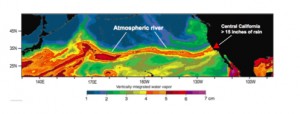New science forecasts include everything except moderation

Two days before Governor Jerry Brown hosts his own conference on “Extreme Climate Risks and California’s Future,” scientists and a smattering of state and local officials spent a rainy Tuesday at Scripps Institution of Oceanography in La Jolla, talking about just that.
It began with calls to keep the funding for statewide climate research. Sacramento legislators may be looking at cutting money to the Public Interest Energy Research (PIER) program in particular, and California Energy Commission vice chair James Boyd told the crowd “all is not well.” He said that research funding is “under assault again” with the weak economy used to question the focus on climate at a time when predictions are becoming more severe.
Our wintertime “atmospheric river” storms known as the “Pineapple Express” will be increasing in frequency and intensity, according to an ongoing investigation by Mike Dettinger, also of Scripps and the U.S. Geological Survey (USGS).
“California’s winter storms are as big as any that strike in the US,” rivaling those in the southeastern “Hurricane Alley” in potential for precipitation, says Dettinger. Funneling data into seven current climate models shows that the most extreme of these events will increase by half or even double in size. “Extreme-season” years in which we would see ten or twenty of these storms also increases by about 50 percent from mid-century on. Think coastal erosion, landslides, power outages, and potentially the largest floods the state has seen.

California heat wave activity is increasing, reported Sasha Gershunov from the Climate Research Division here at Scripps/UCSD. Along California’s coast, both north and south, heat will become more extreme and more frequent, he says, with even the nights staying warmer and becoming more humid (this would appear to run counter to other projections of at least a medium-range “coastal cooling” trend but Gershunov was talking specifically about conditions during heat waves). Gershunov also recapped the “high-confidence” projection of more frequent and more intense droughts for the state, with the southern two-thirds of California even more prone but with the northern end of the state possibly becoming wetter.
